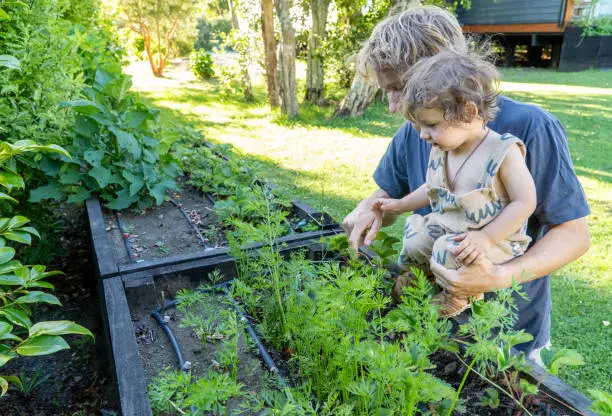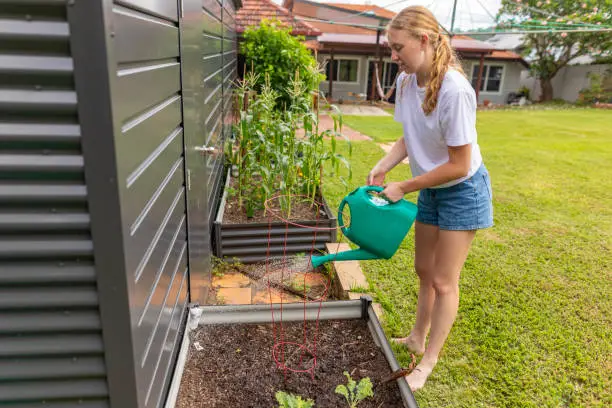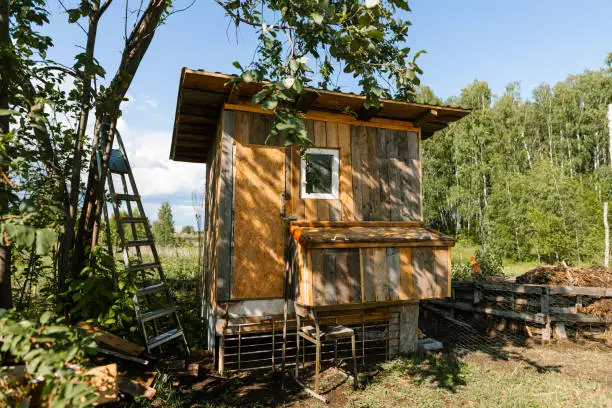Imagine a lush, harmonious garden with every plant, animal, and aspect in place. That’s permaculture’s magic. Like organizing a symphony, every note matters. Let’s explore how to make your backyard homesteading an ecological utopia.
Start with Observation
Stand back and observe before planting. Visit your yard throughout the day and seasons. Note where the sun hits, rain collects, and windy or protected spots are. Like getting to know a new buddy, you must learn their peculiarities before jumping in.
Sectors and zones
Permaculture emphasizes efficiency. Consider dividing your backyard into zones by frequency of use. Zone 1, closest to your home, is ideal for daily-use herbs and veggies. Zone 5 may be a rarely visited wildlife region.
Wind, sun, and water flow affect your garden in several ways. Understanding these components helps you plan and structure your garden correctly.
The Basis of Soil Health
Healthy soil underpins any garden: kitchen scraps and yard debris compost into rich organic stuff that supports plants. Worms are your best friends—they aerate the soil and turn organic matter into nutrient-rich castings.
If your soil is poor, try raised beds, which use rotting wood covered in soil to produce productive mounds.
Management of Water
Water is valuable and life-giving. Install barrels under downspouts to collect rainwater. Use mulch around plants to prevent evaporation. Swales, shallow trenches on contour lines, catch runoff and direct it to thirsty plants.
Instead of watering everywhere, drip irrigation systems distribute water directly to plant roots, saving water.

Plant Guilds: Nature’s Collaboration
Guilds of plants help each other. Plant complementing plants to mimic this:
Beans fix nitrogen in the soil.
Dynamic accumulators: Comfrey absorbs nutrients from deep underground.
Marigolds repel pests.
Ground covers: Clover discourages weeds.
Create micro-ecosystems in your yard for better plants and fewer pests.
Evergreen Powerhouses
Annuals yield quickly but need replacing. Without any work, perennials return year after year:
Fruit trees: Apples, pears
Berry: Blueberries, raspberries
Herbs: rosemary, thyme
Long-term investments that provide food year after year without replanting pay off significantly.
The Animal Allies
Animals are vital to permaculture:
Egg-laying chickens eat pests and fertilize soil.
Bees pollinate flowers, producing abundant harvests.
Through vermiculture, even worms help.
Natural Building Materials
When possible, use natural materials for trellises and fences:
Bamboo grows swiftly into solid poles.
Willows form living fences.
Unlike synthetic materials, these merge into gardens and are sustainable.
Waste Not Want Not
Permaculture stresses closing loops to reduce waste:
Kitchen scraps create compost instead of garbage.
Sink greywater securely irrigates non-edible plants with biodegradable soap.
This approach cuts waste and boosts production sustainably!
Connection to community
Avoid soloing! Join local gardening organizations or neighbors with similar projects:
Share seed/plant/tool/resource/expertise.
Work parties/trade/learn together
Communities build resilience rather than individuals facing hardships alone!
Create Your Own Permaculture Backyard Homesteader’s Patio Garden Guide
Picture this: A green sanctuary greets you on your patio—the smell of fresh herbs and soil mix. You can practically taste the tomatoes ripening on the vine as bees swirl over colorful blossoms. Dreamy, right? It’s more possible than you believe.
Start Small, Dream Big
You don’t need acres to start permaculture. A small patio may support an ecosystem. Containers like pots, buckets, and recycled wooden crates work well. Fill them with good compost and organic soil to start seedlings.
The Magic of Companion Planting
Have you heard “good things come in pairs”? It’s also true for plants! Some plants thrive together. Basil and tomatoes love each other because they fight pests and boost flavor. Marigolds are garden bouncers that deter bugs.
Vertical Gardening: Aim High
Need more floor space? Verticalize! Use trellises, hanging pots, or an old ladder to increase your growing space. Beans and cucumbers love these structures, freeing up land for other crops.

Water wisely.
Overwatering is a newbie mistake that might kill your dreams. Keep plants moist with mulch and water profoundly less often. A rain barrel is an eco-friendly and cost-effective way to collect rainwater.
The Unsung Hero: Soil Health
Good soil is like a balanced diet for plants. Composting kitchen scraps produces nutrient-rich humus that grows plants. You can use worm castings to improve and aerate the soil.
Pest Control Without Chemicals
Stop using pesticides! Ladybugs and spiders control pests. Garlic and chives repel aphids without harming beneficial insects. Sometimes, hosing leaves can remove pests—simple yet effective!
Seasonal Planting: Be Flexible
Each season presents new chances and difficulties. Spring is ideal for lettuce and spinach, summer for peppers and eggplants, and fall for carrots and beets.
Reap What You Sow: Harvest Time
Nothing beats picking fresh food from your garden. Trim herbs periodically to promote new growth and prevent legginess.
Sustainable Practices: Think Long-Term
Permaculture is constructing an autonomous system that benefits you and the environment, not just planting. Use repurposed materials—old pallets make fantastic planters! Rotate crops annually to reduce pests and soil depletion.
Community Connections: Spread Love
Gardening doesn’t require solitude. Share seeds with neighbors or join online or offline gardening organizations (yes, they exist). Sharing gardening advice and surplus produce develops community and knowledge.
When I talked to my neighbor over our shared fence about our gardens, she noted how slugs ate her lettuce harvest overnight—a problem I knew well! Over coffee one morning, we explored ways to protect fragile plants from these slimy invaders. Crushed eggshells worked great!
I mentioned basil before. On an evening stroll through my friend Sarah’s backyard garden party, where everyone was raving about her homemade pesto, she revealed her secret ingredient: freshly picked basil from her permaculture patio garden, which added unparalleled zestiness that store-bought varieties could never match!
Imagine a prosperous, peaceful garden where every plant, animal, and aspect is essential. Permaculture in backyard homesteading is that. Like organizing a symphony, every note matters.
First, inspect your yard. Watch the sun, sea, and breeze. This helps plan zones—Zone 1 for daily-use herbs and Zone 5 for wildlife. Foundational soil is healthy. Compost yard and kitchen waste to enrich it. Worms naturally fertilize and aerate. Use hugelkultur mounds or raised beds for poor soil.
Water management matters. Mulch and rainwater barrels keep the soil moist, and drip irrigation saves water by reaching roots. Guilds of beneficial plants boost development and minimize pests. For long-term yields, include perennials like fruit trees, berry bushes, and herbs.
Animals are vital. Bees pollinate, and chickens eat vermin and fertilize. Use bamboo and willow for eco-friendly construction. Compost and reuse greywater to reduce waste.
Community involvement. Cooperatively share resources and information in local gardening groups. Your garden can be an ecological paradise that benefits you, the environment, and your neighborhood.




Leave a Reply
You must be logged in to post a comment.